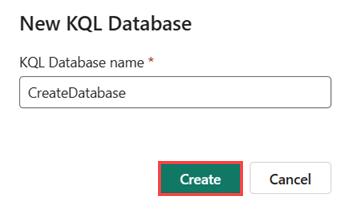Note
Access to this page requires authorization. You can try signing in or changing directories.
Access to this page requires authorization. You can try changing directories.
In Real-Time Intelligence, you interact with your data in the context of eventhouses, databases, and tables. A single workspace can hold multiple Eventhouses, an eventhouse can hold multiple databases, and each database can hold multiple tables.
In this article, you learn how to create a new KQL database. Once your KQL database has data, you can proceed to query your data using Kusto Query Language in a KQL queryset.
Prerequisites
Create a new KQL database
To create a new KQL database, in the Eventhouse explorer either:
Select Eventhouse then New database +
Under KQL Databases select +

Enter your database name, select your database type, either New database (default) or New shortcut database (follower), then select Create. For information about follower databases, see Create a database shortcut.
Note
The database name can contain alphanumeric characters, underscores, periods, and hyphens. Special characters aren't supported.

The KQL database is created within the context of the selected eventhouse. You can also Create an empty table.
Explore your KQL database
When you create a new KQL database, an attached environment is automatically created to explore and manage the KQL database using KQL queries. For more information, see KQL overview.
To access the query environment, select KQLdatabasename_queryset from your KQL database object tree.

To rename the query environment, select the Pencil icon next to its name, and enter a new name.
